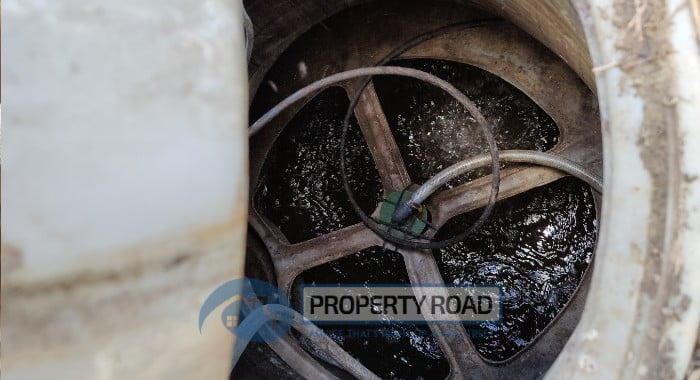One of the most important aspects of conveyancing is the issue of buying a house with a right of access.
Buying a home means you will be checking its legal title that will determine whether it is good and marketable – including whether your home has sufficient access.
This is something we experienced first-hand when we bought our current property. It has a right of access agreement in place as the sewage treatment plant is located on the neighbours land. We have an agreement in place for this and for us to be able to access the plant for emptying and maintenance.
You also need to check whether there is a right of way that enables you to access the property and exit it.
For those who are buying a property, you need to be aware that the law that affects rights of access in this country has evolved over the years and the subject can be quite confusing.
However, it’s an important subject to discuss because it’s one of those problems that will divide the community or see neighbours heading to the courts in a dispute over their rights of way and access.
There’s no doubt that this issue can be a legal minefield, so you need to tread carefully.
And you also need to consider how you will feel about neighbours walking past your windows every day before you decide to make an offer on a property you love that happens to have a right of way across your front garden. These do exist, so be aware.
Issues with rights of way
There are several common problem areas for residential properties where rights of access can become an issue. The most common ones tend to be:
Shared driveway
Without having a right of way in place, you will be unable to access your property and you need to ensure that there is a right of way provision for pedestrian and vehicle access.
Parking
You need to understand that while a right of way may be in place, it does not include a right to park. You need to check that parking is included as a right separately.
Stairway access
Whenever you lease or purchase premises that are above ground level, you will need a right of access over any stairways.
It’s also worth mentioning the term ‘ransom strip’ – this is a strip of land that will sit between a highway and your property, and it needs to be investigated because you will need a right of way across it.
Easements
Easements is a word used to describe private rights-of-way and may include:
Implied
This is a right of way that is required from necessity
Granted expressly
This is a right of access over a neighbour’s land or having a right to use and connect to private drains. You will need to check your title deeds to see if this right of access has been granted expressly

Prescription
Be aware too that a right of way may have arisen over private land, for example, if a footpath has been in use continuously for at least 20 years, this will create a right of way that is legally binding.
When it comes to establishing a right of way, there’s no doubt that this is a complex area of law and before proceeding with a property purchase, you really should seek legal advice if you have any worries or concerns over access to your property or land.
Later in this article, we look at what you can do to remove a right of access.
Access

Another issue when it comes to a right of way is having access to your home or property.
For example, your property may be on a public adopted road which is a road that is maintained by the local council so local ratepayers pay for its upkeep.
So, if your property borders a public adopted road, it will usually have a right over the road so access is not a specific requirement in the property’s registered title.
During the conveyancing process, the local property search will highlight whether the road is adopted or not, and your conveyancing lawyer will confirm your exact position before contracts are exchanged.
Access also needs to be understood because if you are buying a property that does not have legal access, then it will be considered to be ‘landlocked’.
This also means that your property will not be ‘good and marketable’.
Again, during the conveyancing process, the conveyancer has an obligation to report this issue to your mortgage lender.
That has an impact if you are using a mortgage to buy a property because they may then decide to withdraw their mortgage offer.
The issue of right of access can be either large or small. For instance, when we bought our current home, there was already an agreement in place for right of access. That was there because there is a small parcel of land out the back of our land which belongs to the neighbour.
Previous owners had made an agreement with the neighbour for the septic tank (or sewage treatment plant in our case) to be located there. Naturally, that means an agreement was needed, both for something belonging to us to be on their land, and for unrestricted access to access the plant to empty it, repair it, or service it.
For us, the right of access agreement was only a very small issue. It only needed our conveyancing solicitor to check the agreement to ensure there were no legal concerns. Once he was satisfied, our purchase could proceed.
Buying A Property? FREE Step-By-Step Platform
How to check your access rights
When buying a property, you must check the access rights attached to it.
It’s here that your conveyancing solicitor will investigate the property’s access, which would be part of the title investigation.
They will begin this part of the conveyancing process when they receive the contract pack from the property seller.
Your conveyancer will also carry out an ‘Index Map’ search to see if the access is registered or not.
Should the access be registered, the seller’s solicitor will have to contact the owner to formalise their position as part of the pre-contract enquiries.
These enquiries will see the conveyancer carefully checking the property information form that has been supplied by the property seller, as well as the title deeds.
If there is a reference in older deeds – or in ‘recited’ documents – to a right of access, then the property’s registered title will need to be amended to reflect the right of access – for example, over a private road.
It’s at this point your conveyancer will ask for a ‘statement of truth’ from the current owner, as well as statutory declarations, to support the change in the title with the Land Registry.
This declaration will confirm:
- How long the ownership of the property has been in place;
- How long access has been available;
- Whether this access has any issues.
The conveyancer may also ask the property’s neighbours to provide statutory declarations or a ‘statement of truth’ to help support the property buyer’s application of access.
Property seller may still have indemnity insurance

It’s worth noting too that the property seller may still have indemnity insurance in place from when they bought their property, especially if they encountered issues with access.
Your conveyancer will then be able to review the policy’s requirements and determine whether its cover is acceptable in the circumstances.
And while your conveyancer may be required to report this access issue to your mortgage lender, they will submit evidence that shows that access has been in use for a certain period of time, so the lender may take a view on the matter.
It’s here that the mortgage lender may also insist that you buy indemnity insurance, and your conveyancing lawyer will be able to advise about what this means, and what will be required to meet the lender’s requirements.
Usually, indemnity insurance will be part of the pre-contract enquiries, and this policy will be paid for, usually, by the property seller.
Also, when you come to sell the property, the conveyancer will ensure that the insurance policy covers ‘successors in title’ which effectively means whoever buys your property.
Before there is an exchange of contracts, your conveyancing solicitor will need to:
- Provide you with an overview of the ownership;
- Explain the property rights affecting the property you are buying.
Indeed, if you are buying with a mortgage, the conveyancer will also need to ensure that all of the mortgage conditions have been met before a deposit is requested.
After this point, the exchange of contracts will take place and you will be legally bound to complete the transaction.
Your future access rights
When you are buying a property or land, it’s crucial that you know everything there is to know about your property rights before buying.
As explained, an easement is your legal right to exercise a privilege over someone else’s land.
This means that either you as an individual, or the public, can cross or use someone else’s land for various purposes.
Easements are commonly used in the form of a right of access, right-of-way or rights of drainage utilities.
As mentioned earlier, perhaps the best way to protect yourself in future from potential legal disputes is to invest in indemnity insurance.
This is a relatively cheap way for a buyer or seller to protect themselves from any potential future liabilities.
It’s also possible for the property buyer to insist that the seller buys an indemnity policy before the sale goes ahead.
The conveyancing solicitor will find a specialist indemnity insurance provider and it is usually expected that the seller will pay for this because it’s their lack of evidence or paperwork that may be hindering the property sale.
Be aware though that all indemnity insurance policies will have a clause stating the insurance will be invalidated if the existence of a problem is revealed to a third party.
As the buyer, you will need to discuss what your future plans for the property will be with the conveyancing solicitor to ensure that the correct indemnity insurance is purchased.
Easement indemnity policy costs
An easement indemnity policy is designed to bring peace of mind to property developers and owners and will:
- Cover the financial costs of you defending the continued use of an existing access, whether that’s by car or on foot;
- Used for defending the existing services that have been in continuous use for at least 12 months without consent or complaint from the current owner – providing that the access has been used regularly.
For anyone who is selling or buying a property and is gaining access via unregistered land, then an indemnity policy may well be recommended by the conveyancing solicitor.
This insurance will then ensure that you can take legal action should you need to defend your right to access.
However, the cost of easement indemnity policies does vary, depending on the property.
The insurer will need to know if the land you are using to access your property is unregistered, and also review the title deeds to the property and also those for the surrounding properties.
Removing the right of access on your property

There may be concerns having moved into your property, that the right of access or easements need to be removed.
For example, celebrities often make the news when they want to remove a right of access to their land by closing a public path. However, while such a move may bring privacy, it also needs to be understood:
- Removing an easement from property or land is difficult;
- Removal of access will need the consent of those who benefit from a right of access;
- The legal process can be a complicated and time-consuming;
- You will certainly need legal advice.
You will also need to appreciate that an easement that has been created by deed cannot, usually, be revoked other than by using another deed – irrespective of how long that easement may have been in place.
However, there is one way of doing so and that is to prove that the purpose of the easement on your land no longer exists.
You may find that you can also remove an easement if those who benefit from it agree to release their rights – for example, if you want to build a permanent structure across what is an established right-of-way.
Also, you must never assume that a lack of use over a right of access will be sufficient grounds in having that easement revoked.
There are also some cases of easements expiring after a period of time. You will need to check whether the easement has a defined period that was granted for a specific purpose and is now no longer being served.
Again, the rules over access and easements can be complicated, and there’s a lot of case law covering the subject so legal advice should be sought.
Tips for buying a house with right of access
Whether you have found your dream home, or are making an investment purchase, having the right of access to your property or land is crucial.
This is an important part of the conveyancing process, and you need to be reassured that when the seller says there is a right of access, that this exists legally on the title deed.
You should also consider having indemnity insurance should this prove not to be the case.
And with all things legal, including the conveyancing process, you should always seek professional legal advice to ensure you are protected and get to enjoy your property and land without worrying about rights of access or easements.





